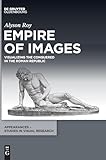Empire of Images : Visualizing the Conquered in the Roman Republic / Alyson Roy.
Material type: TextSeries: Appearances – Studies in Visual Research ; 5Publisher: Mnchen ; Wien : De Gruyter Oldenbourg, [2024]Copyright date: 2024Description: 1 online resource (XVII, 166 p.)Content type:
TextSeries: Appearances – Studies in Visual Research ; 5Publisher: Mnchen ; Wien : De Gruyter Oldenbourg, [2024]Copyright date: 2024Description: 1 online resource (XVII, 166 p.)Content type: - 9783111325347
- 9783111327624
- 9783111326634
- 709.37 23
- online - DeGruyter
- Issued also in print.
| Item type | Current library | Call number | URL | Status | Notes | Barcode | |
|---|---|---|---|---|---|---|---|
 eBook
eBook
|
Biblioteca "Angelicum" Pont. Univ. S.Tommaso d'Aquino Nuvola online | online - DeGruyter (Browse shelf(Opens below)) | Online access | Not for loan (Accesso limitato) | Accesso per gli utenti autorizzati / Access for authorized users | (dgr)9783111326634 |
Frontmatter -- Acknowledgments -- Contents -- List of Figures -- Maps -- Introduction -- Chapter 1 Visualizing Empire: Conquest Imagery in the Gallic Provinces -- Chapter 2 Coining an Image: Conquest, Rebellion, and the Language of Power in Roman Iberia -- Chapter 3 Rome and the Greek East: Overwriting and Cowriting Conquest -- Chapter 4 Conquest Kitsch: Moving Iconography from Public to Consumer Contexts -- Conclusion -- Bibliography -- Index
restricted access online access with authorization star
http://purl.org/coar/access_right/c_16ec
Rome was an empire of images, especially images that bolstered their imperial identity. Visual and material items portraying battles, myths, captives, trophies, and triumphal parades were particularly important across the Roman empire. But where did these images originate and what shaped them? Empire of Images explores the development of the Roman visual language of power in the Republic in Iberian Peninsula, the Gallic provinces, and Greece and Macedonia, centering the development of imperial imagery in overseas conquest. Drawing on a range of material evidence, this book argues that Roman imperial imagery developed through prolonged interaction with and adaptation by subjugated peoples. Despite their starring role in Roman imagery, the populations of Rome’s provinces continuously reinterpreted and reimagined Roman images of power to navigate their membership in the new imperial community, and in doing so, contributed to the creation of a universal visual language that continues to shape how Rome is understood.
Issued also in print.
Mode of access: Internet via World Wide Web.
In English.
Description based on online resource; title from PDF title page (publisher's Web site, viewed 20. Nov 2024)


